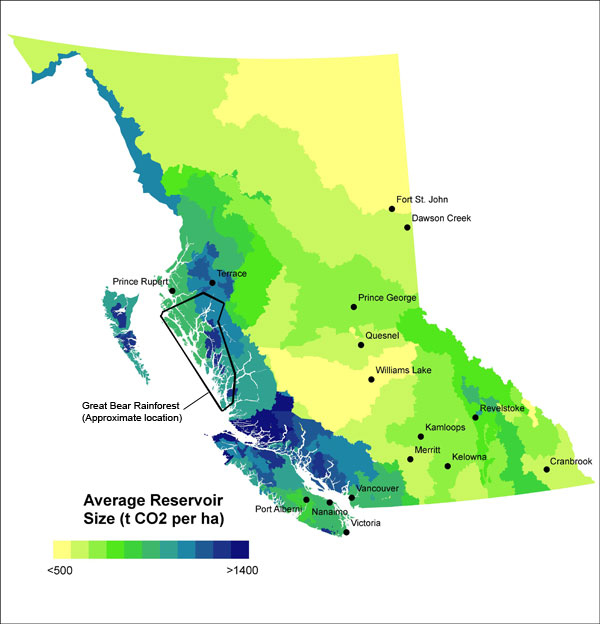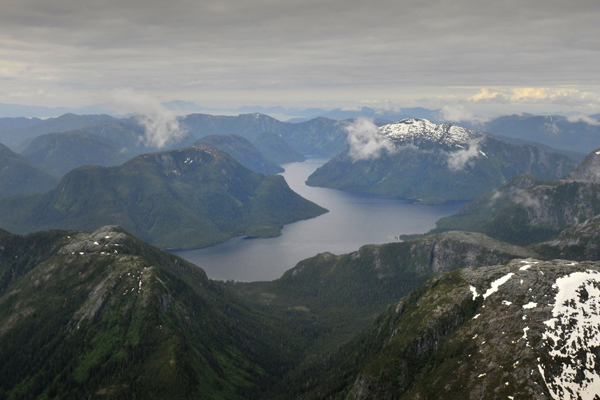In a young man's eyes the logging that laid waste to the coastal forest was akin to a military invasion.
Cameron Hill was barely a teenager when loggers descended onto Gitga'at First Nation territory in the early '80s, clear-cutting vast stands of old-growth cedar in the midst of what is now known internationally as the Great Bear rainforest.
"We still have huge blocks of our territory decimated from those clear cuts," says Hill, now 44, a band councillor and school teacher in the remote north coast village of Hartley Bay. "The land was raped while we watched, and we don't ever want to see that again."
An unprecedented new carbon offset project, among the largest ever conceived, promises industrial logging will not return.
Beginning this year, the Gitga'at and seven neighbouring First Nations (see sidebar "The Coastal First Nations") will "harvest" one million tonnes of "carbon offsets" from the Great Bear Rainforest, sharing millions of dollars in revenue with the province over the next century.
That harvest was created, counterintuitively, by putting vast areas of the Great Bear off-limits to industrial-scale logging. By leaving more trees standing, the First Nations are able to sell certificates attesting to the increasing volume of carbon stored in their roots, leaves and fibre. Purchasers may claim the carbon thereby removed from the atmosphere to offset their own direct greenhouse emissions.
Hill, who teaches math and physical education in Hartley Bay, says the deal is bigger than the revenue it will earn, or even the climate change it may forestall; the Gitga'at, unlike most British Columbians, still rely almost entirely on their wild surroundings for daily sustenance.
"Money from carbon is not the end-all, be-all for us," he says. "The Gitga'at way of life is what is most important, and however we can preserve that, we're open to the options and opportunities."
Options and opportunities
The pending carbon deal is a precedent that could open the floodgates for other First Nations, private companies, and community forests to profit from a uniquely 21st century forest resource: the carbon held in B.C.'s estimated 55 million hectares of forest, packaged into tradable financial instruments and sold as a commodity around the world.
Given that forests and the soil beneath them are responsible for almost all of the world's land-based carbon sequestration, attempts to put a dollar value on forest carbon are an important step forward in the fight against climate change, albeit steps beset by hurdles and shackling complications.
The Great Bear project is among the biggest forest-carbon projects every conceived, in the same league as the 1.8 million tonne Juma Reserve in the Brazilian Amazon.
"The Great Bear Forest project is at a scale that dwarfs everything else that's gone before," says Valerie Langer of ForestEthics Solutions, who helped the province develop its rules for forest offset projects.
That makes it unique -- for now. But the project may also be a trend-setter, Langer says. "If this is done right, it will apply to forests across the province. This is not a one-off deal."
To accomplish the massive deal, the Great Bear project was split into four pieces. In all, eight participating First Nations have agreed to practice "ecosystem based" forest management that will slash timber harvest over a total land base of 5.4 million hectares. In place of retaining the minimum tree cover required by law (about 30 per cent), the new plan preserves at least 50 per cent, and as much as 80 per cent, of standing growth.
How it unfolded
The Coastal First Nations collectively agreed in December 2003 to explore the option of earning carbon offsets as part of their land use planning process. They went on to establish a carbon working committee just before the B.C. government announced that it would protect a chunk of the Great Bear roughly the size of Belize in early 2006.
Hill says the biggest challenge for the Gitga'at was overcoming their distrust of the provincial government. But upon closer scrutiny, they came to see the carbon project as a unique opportunity. Implementing "improved forest practices" to facilitate carbon storage would serve both the Gitga'at desire to stop the clear-cutting and their wish to develop a lower-impact economy based on ecotourism.
"We've got people flocking into our territory to take in the pristine wonder of it," Hill says, "And to me, if it's employing our people and not disrupting the Gitga'at way of life, it's a win-win."
Funding to create the offsets was available: as part of the political deal to create the Great Bear Rainforest protected areas, government and private philanthropists had assembled a $120-million pot of money to help develop an alternative economy and smooth the transition from business-as-usual forestry to ecosystem based management. (A $60-million federal/provincial contribution provides for First Nation economic development initiatives; an equal portion from philanthropists funds conservation management and research).
A breakthrough came late in 2009, when Coastal First Nations and the provincial government agreed in principle to divide any potential revenue from carbon offsets between them. Last year, a formal "atmospheric benefit sharing agreement" was signed -- essentially a profit-sharing deal for the carbon contained in trees standing on real estate that is both First Nations territory and Crown land in the eyes of the law. It decreed that after transaction costs, revenues from Great Bear carbon sales would be split 50/50 between the government and First Nations.
It was an historic moment: First Nations and government temporarily set aside the issue of contested land title and agreed to share in the benefit and responsibility of maintaining the carbon on the land for a century.
Yet the breakthrough came with surprising speed, considering that most treaty negotiations in the province have been stalled for decades. Langer says the province was motivated to complete the carbon deal because the Pacific Carbon Trust -- the Crown corporation set up to acquire 600,000 tonnes worth of offsets each year to "neutralize" emissions from B.C.'s public service -- was struggling to find enough home-grown offsets to meet that demand.
"There was just not enough volume available in B.C. for [the required] offsets," Langer observes, "so all of a sudden, when a potential project came around that had a large volume of carbon, it was of interest."
New rules = new markets
Despite that interest, advocates for selling carbon offsets from the Great Bear were dogged by a question: outside of the B.C. government, who else would buy their carbon certificates?
Up to now, markets for B.C. forest-carbon offsets have been limited by a lack of internationally recognized rules (called "protocols"), which prescribe how offsets are created. Many companies and other organizations internationally buy carbon offsets, either for reasons of reputation or to meet government mandates. But because of the number of variables involved, offsets not created using recognized protocols are of small interest to most buyers.
In 2008, the provincial government's Climate Action Secretariat, working with Pacific Carbon Trust, set to work developing a protocol for offset projects in B.C. forests. When they were eventually adopted as the B.C. Forest Carbon Offset Protocol (or FCOP), the Coastal First Nations became the first to apply the new rules.
The province hopes they'll be followed by others. With the FCOP in place, B.C. policy-makers hope to see B.C.-"grown" forest-carbon offsets qualify for sale to greenhouse emitters in Quebec and California, when both jurisdictions commission their planned Western Climate Initiative carbon cap-and-trade systems next year. The province is also seeking acceptance for FCOP under the Verified Carbon Standard, among the highest standards for voluntary offsets in the world. Acceptance under that standard would qualify FCOP offsets for sale into a global voluntary-reduction offset market worth over US$420 million in 2010.
Monetizing Great Bear carbon
Meanwhile, Coastal First Nations policy analyst Gary Wouters says that an agreement in principle has already been struck with the PCT to buy the Great Bear offsets.
While it's too early to say exactly how much money is in play (Langer estimates the first "tranche" of Great Bear carbon will earn First Nations close to $3 million), Wouters says they hope to earn a premium for these offsets.

"We want to use the branding of the Great Bear Rainforest and the nature of the unique biodiversity we've created here," says Wouters. "We think Great Bear carbon will be worth more than growing alder trees in Langley."
Wouters sees that potential for "charismatic" carbon offsets in places like the Great Bear -- where exceptional biodiversity values and even social benefits can be bundled together with the carbon stored in forest fibre as added values for which some buyers may be willing to pay extra money.
(How carbon offsets are being "bundled" with these other biodiversity, social and ecosystem service values will be the subject of an upcoming TSS feature: stay tuned.)
Briony Penn, who spent two years in discussions over the development of the new B.C. forestry offset rules as a contractor to the Land Trust Alliance of BC is concerned about some of their contents, especially the inclusion of carbon stored as a result of either reforestation and "afforestation" (planting trees where none existed before). "If you're going to get into the business of offsets with forests," Penn says, "the most effective form of [carbon] mitigation is to stop cutting down forests in the first place."
The same deliberations heard ForestEthics' concern that squeezing the maximum amount of carbon credit out of B.C. forests might compromise other biodiversity values. For example, a future project might clear-cut old growth forests in order to plant "super tree monocultures" genetically modified to suck up carbon and generate a maximum number of saleable offsets.
The cost of carbon leakage
While many criticisms have been made of carbon offsets as a tool for putting a price on carbon, meeting rigorous standards to bring the Great Bear offsets to market has cost First Nations millions of dollars, says Gary Wouters.
He estimates that nearly half the carbon being sequestered in forests in the north and central coast has been set aside from offset sale to account for something known as "leakage."
Carbon "leaks" from the Great Bear like this: if Coastal First Nations reduce their timber harvest to sequester more carbon, their former customers will simply buy wood and fibre elsewhere. If they end up buying those from poorly managed forests with high emissions, the reduction of activity in Great Bear in order to store carbon there could be held indirectly responsible for creating additional emissions somewhere else in the world -- negating the atmospheric benefit that offsets purport to certify.
Under the province's new forest-carbon rules, developers must identify where the market will turn to replace the timber supply they intend to remove from the market, and estimate how much carbon will "leak" that way.
Tim Lesiuk, executive director of business development at the Climate Action Secretariat, says the new B.C. rules accounting for leakage err on the side of caution. "FCOP is seen as overly conservative or not producing enough offsets," he concedes, "but [this ensures] it is doing at least as much good for the atmosphere as it says, and probably more."
Private sector to the rescue?
First Nations in the Great Bear aren't the only ones getting into forest-carbon offsets in B.C. In January 2012, the province invited proposals from private interests willing to reforest Crown land damaged by mountain pine beetle and wildfire in exchange for carbon offset revenues from the newly-planted forests.
For the 2012 planting season, the ministry had hoped to target between 500 and 2,000 hectares of Crown land, with plans to increase that to as much as 10,000 hectares annually by 2015. A Pacific Carbon Trust press release says "banks, carbon finance companies, silviculture firms and First Nations can generate significant carbon credits, which they will be able to sell on the open market as the carbon storage value of these replanted areas increases over time."
In April, Ministry of Forests, Lands and Natural Resource Operations (MFLNRO) spokesperson Vivian Thomas confirmed that four proposals had been received to date, with one under active negotiation. None of the proposed terms were being made public. "This program is a creative way of encouraging the replanting of these areas that generates carbon credits for program partners and reduce the burden of taxpayers," Thomas said. Briony Penn doesn't see it this way at all. If the public subsidizes the planting of trees for future generations, then that money needs to flow back in some way to communities and taxpayers, she argues (see sidebar "Whose Carbon? Whose Cash?").
"These decisions are being made now, and there has been absolutely no public discussion about carbon in British Columbia," Penn says.
In June, just as this story was going to print, ministry spokesperson Thomas told Tyee Solutions that the one deal under negotiation had fallen through. "Given the tight timelines, the proponent wasn't able to get the necessary financing together to meet timelines for this year's planting season," she said of the aborted deal. She added that the ministry will be posting another request for proposals in the late summer for the 2013 planting season.
First Nations not racing to get involved
Despite the lure of new revenue, Gary Wouters remains skeptical that many First Nations outside the Great Bear Rainforest will follow its path in the short term.
The upfront costs of defining and qualifying a project, and ongoing management work, are too onerous for most smaller First Nations, he says. "Unless you come together as a collective group and take advantage of the economies of scale, some small First Nations couldn't afford to do it."
The GBR carbon project was also the result of unique circumstances difficult to replicate: there was acceptance of the "ecosystem-based" forest management system by government, and funding specifically dedicated to developing a lower-carbon forest economy.
For other First Nations to seize the same opportunity, Wouters says the province would need to reopen existing land-use agreements and entertain new protected areas and reduced timber harvests on Crown land.
Importance of Great Bear carbon
None of this diminishes the precedent set in the Great Bear. Carbon being drawn from the atmosphere is being captured in forests on land the Crown and First Nations contest -- then packaged into offsets and sold with the profits shared by both. The parties have agreed to set aside their treaty impasse and manage the land for carbon over the next 100 years.
If nothing else, it has bought some time in which to do more.
"The Great Bear is that first little baby step on carbon," says Briony Penn. She says its success could lead to a day when the cost of carbon emissions are factored routinely into every decision government and citizens make. "Once Great Bear is completely figured out, we will all know exactly how much carbon is released into the atmosphere every time a hectare of coastal rainforest is cut down," predicts Penn.
The win-win of generating revenue from keeping more forests standing is already apparent in Hartley Bay, where five nights a week Cameron Hill's family eats deer, moose or seafood they have harvested together during the year. The forests also provide medicine, and the raw materials supplying a renaissance in Gitga'at wood carving, weaving and blanket making.
More than a revenue stream, the carbon deal means the Gitga'at have a new level of food, resource and even cultural security. Clear-cutting has been replaced by gentler forays into the woods: later this month, Hill will take his class out to harvest cedar bark for Hartley Bay's weavers.
"I can't stress it enough," he says, "we can go and take from a tree and give it thanks, look after it, and it will heal and never be gone." ![]()
Read more: Politics, Labour + Industry, Environment
















Tyee Commenting Guidelines
Comments that violate guidelines risk being deleted, and violations may result in a temporary or permanent user ban. Maintain the spirit of good conversation to stay in the discussion.
*Please note The Tyee is not a forum for spreading misinformation about COVID-19, denying its existence or minimizing its risk to public health.
Do:
Do not: